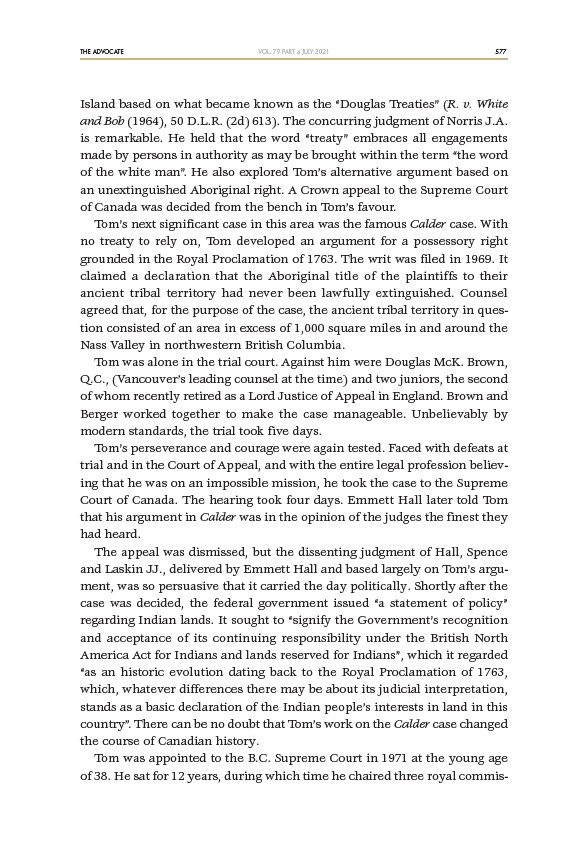
THE ADVOCATE 577
VOL. 79 PART 4 JULY 2021
Island based on what became known as the “Douglas Treaties” (R. v. White
and Bob (1964), 50 D.L.R. (2d) 613). The concurring judgment of Norris J.A.
is remarkable. He held that the word “treaty” embraces all engagements
made by persons in authority as may be brought within the term “the word
of the white man”. He also explored Tom’s alternative argument based on
an unextinguished Aboriginal right. A Crown appeal to the Supreme Court
of Canada was decided from the bench in Tom’s favour.
Tom’s next significant case in this area was the famous Calder case. With
no treaty to rely on, Tom developed an argument for a possessory right
grounded in the Royal Proclamation of 1763. The writ was filed in 1969. It
claimed a declaration that the Aboriginal title of the plaintiffs to their
ancient tribal territory had never been lawfully extinguished. Counsel
agreed that, for the purpose of the case, the ancient tribal territory in question
consisted of an area in excess of 1,000 square miles in and around the
Nass Valley in northwestern British Columbia.
Tom was alone in the trial court. Against him were Douglas McK. Brown,
Q.C., (Vancouver’s leading counsel at the time) and two juniors, the second
of whom recently retired as a Lord Justice of Appeal in England. Brown and
Berger worked together to make the case manageable. Unbelievably by
modern standards, the trial took five days.
Tom’s perseverance and courage were again tested. Faced with defeats at
trial and in the Court of Appeal, and with the entire legal profession believing
that he was on an impossible mission, he took the case to the Supreme
Court of Canada. The hearing took four days. Emmett Hall later told Tom
that his argument in Calder was in the opinion of the judges the finest they
had heard.
The appeal was dismissed, but the dissenting judgment of Hall, Spence
and Laskin JJ., delivered by Emmett Hall and based largely on Tom’s argument,
was so persuasive that it carried the day politically. Shortly after the
case was decided, the federal government issued “a statement of policy”
regarding Indian lands. It sought to “signify the Government’s recognition
and acceptance of its continuing responsibility under the British North
America Act for Indians and lands reserved for Indians”, which it regarded
“as an historic evolution dating back to the Royal Proclamation of 1763,
which, whatever differences there may be about its judicial interpretation,
stands as a basic declaration of the Indian people’s interests in land in this
country”. There can be no doubt that Tom’s work on the Calder case changed
the course of Canadian history.
Tom was appointed to the B.C. Supreme Court in 1971 at the young age
of 38. He sat for 12 years, during which time he chaired three royal commis-